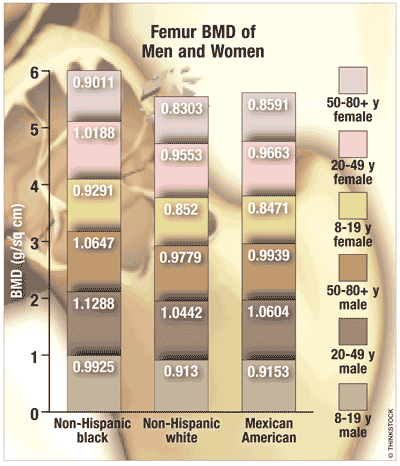US Pharm. 2012;37(10):8.
The surgeon general’s report states that, by 2020, half of all Americans aged ≥50 years will have weak bones unless they change their diet and lifestyle. Thirty years ago, health care professionals believed that weak bones and fractures were facts of aging and that little could be done, but today’s physicians know how to improve bone health and can detect and treat bone diseases.

Children: Strong bones begin in childhood. Calcium and vitamin D intake and weight-bearing physical activity help determine bone mass. Activities such as running, dancing, climbing stairs, and weightlifting can boost bone development, and the best weight-bearing activities are team sports. Lack of physical activity results in loss of bone mass, especially during long periods of immobilization or inactivity. In the years of peak skeletal growth (ages 8-19 years), youngsters accumulate more than 25% of adult bone. By the time teenagers finish their growth spurt (about age 17 years), 90% of their adult bone mass is formed, and the bones continue to increase in density until about age 30 years.
Osteoporosis: Approximately 40 million people have osteoporosis or are at high risk because of low bone mass. Osteoporosis develops when bone resorption occurs too quickly or when replacement occurs too slowly after peak bone mass is reached. Osteoporosis is more likely to develop if a person did not reach optimal peak bone mass during the bone-building years. In women, bone loss is fastest (20%) the first few years after menopause and continues into the postmenopausal years.
Bone Mineral Density (BMD): Irrespective of age and race, females have lower BMD than males, according to the 2005 National Health and Nutrition Examination Survey. Among non-Hispanic black subjects aged ≥50, 20–49, and 8–19 years, females had 15.4%, 9.7%, and 6.4% lower BMD, respectively, than males. Mexican American women aged ≥50 years had the least difference in BMD versus men. As males’ age progressed from 8–19 to 20–49 years, BMD increased by 15%, versus 12% in females. With progression to ≥50 years, however, BMD dropped more in women (12%) than in men (6.1%).
Fractures: Each year, 1.5 million older people suffer fractures because their bones have weakened. An elderly person who breaks a hip is four times more likely to die within 3 months or experience a downward spiral in health. One in 5 hip fracture patients ends up in a nursing home within 1 year; others may become isolated or depressed or restrict their mobility because of fear of falling. The expense of treating broken bones from osteoporosis is $18 billion annually.
To comment on this article, contact rdavidson@uspharmacist.com.






